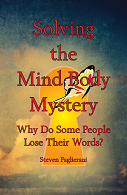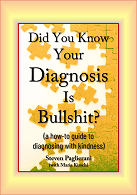
Therapy for Therapists (a guide to changing lives)
978-0-9844895-9-6 $49.95
Can People Actually Change?
In almost every therapist lies an inherent flaw. This flaw prevents them from helping clients to make lasting changes. Temporary changes; the usual, will-powered, behavioral and cognitive kind? They can get clients to do those. But permanent changes, the kind which alter the client's very nature? Not so much.
The flaw? To get licensed, they must learn to imitate what the great therapists did. Ironically, those great therapists were great because they didn't do this. Rather, what made them great was that they were being themselves. And being themselves IS what gave them the power to change lives.
In this book, Steven Paglierani draws on his three decades of experience to teach therapists to be themselves, with practical suggestions, poignant stories, and heart-felt advice on everything therapists do. Practice management and better self-care to cutting-edge therapies based on his school of therapy, The Emergence Therapies. Do you want to learn to actually change lives, while falling in love what you do? If you’re willing to do the work, then this book will show you how.
PSY028000 PSYCHOLOGY / Practice Management
PSY046000 PSYCHOLOGY / Psychotherapy / General
On Therapists Being Themselves
There's so much I could say about what makes this book unique. But I worry, whatever I say will just sound like common therapist bullshit. In an effort to address this, I've placed a few exerpts from the Table of Contents below. Besides this though, I want to mention a few things you may find interesting.
To begin with there are four sections, sixteen chapters, more than 300,000 words, and over 700 pages. And despite the occasional jargon, none of it is boring or dry, or anything other than personal and warm.
What's in these Sections and Chapters? If you're interested, here's the short list. [Warning. Therapist's jargon ahead.]
- Therapy Practice Basics (Getting & Keeping Clients, Stories, Tips & Pointers, Therapy & the Room, Bookkeeping & Paperwork)
- Therapy Session Basics (Burnout, Boundaries, & Rapport, Getting Lost in Sessions, Paper Therapies, Is It Time To End Therapy?)
- The 4 Fundamental Skills (Therapy & Regression, Therapy & Transference, Therapy & Wounds, Therapy & Healing)
- The 4 Emergence Therapies (Visual Dialogue, Direct Emergence, Layered Memory, Mirror Work)
Of particular note is the section devoted to the science behind changing a life. Know it passes the Rutherford test. You can teach it to the barmaid. This section alone should improve every one of your therapist skills. It will also likely challenge much of what you believe about what does and doesn't make therapy succeed.
Another difference occurs in the End Notes which follow each section. No book on therapy includes a teacher's students seriously challenging him. Here my two apprentices, Sam and Maria, push me for evidence for my claims. Admittedly, in these exchanges, they often teach this old dog as much as I teach them. Sometimes more.
As for the samples from the Table of Contents, just click the "Show More" link. And for samples of the warm stuff, click the Short Readings menu tab.
Section 1 - Chapter 14 - Therapy Practice Basics (what can I learn about . . . )
Referrals and Community Contacts
Platinum Level Referrals
Gold Level Referrals
Silver Level Referrals
Bronze Level Referrals
Therapist's Practice Health Test #1: Referral Levels
After the Referral - First Contacts
Fee Setting, Missed Sessions, & Co-pays
Sliding Scales and Setting Fees
Supervision and Supervising
Dealing With “Scheduling Resistance”
Session Time-Limits and Running Over
Double Booking and Forgetting Appointments
Responding to In-Office Violence
Noticing the Direction of the Aggression
Cases of Clients Unexpectedly Ending Therapy
Practice Health Test #2: Thinking You Know the Reasons
Expecting to Be Blamed for Office Violence
First Sessions: Do You Or Do You Not Prepare?
First-Session Pre-Game “Warm-ups”
Noticing the Details of a Session’s First Minute
On Being Yourself as a Therapist
An Example of Being Yourself in the First Minute
Therapeutic Profanity & Cursing in Sessions
Teens, Cursing, and Earning Respect
When Clients Get Seriously Ill
Dealing with Suicide in a First Call - #1: Cleo
Dealing with Suicide in a First Call - #2: Irish Jim
How Did Jim’s First Session Go?
Contrasting and Comparing These Two Cases
Dealing with Suicide in a First Call -#3: Lara
Secrets, Privacy, and Confidentiality
Closing Thoughts & Knowing Your Limits.
Section 2 - Chapter 18 - Burnout, Boundaries, & Rapport (what can I learn about…?)
The Most Common Error Therapists Make
What Do You Focus On In Therapy Sessions?
What Is Rapport?
Can Boundaries Destroy a Family?
How Do You Build a “Bridge of Similarity?”
Use What People Bring In To Build Bridges
Rapport, Regression, and Healing
How Do You Get Clients to Feel Safe?
Can A Child Molester Change?
What About Clients Burning Out?
How “Offering Advice” Leads to Burnout
Do Ideas Have A Place in Therapy?
Can A Spiritual Maxim Save A Life?
Tailor Your Ideas To The Client’s Developmental Age
Why Focus on Children?
Why Ideas Discourage Empathy
Are My Ideas Beginning to Burn You Out?
The Codependency Story
Burnout and Rapport in Supervision
Don’t Overlook “Informal Supervision”
Burnout and Rapport With Colleagues
Burnout and Rapport With Referral Sources
Therapy As Cycling Between Burnout And Rapport
Burnout and Rapport as a Pair of Opposites
Creating the Connection
Books by Steven Paglierani



.png)

.png)